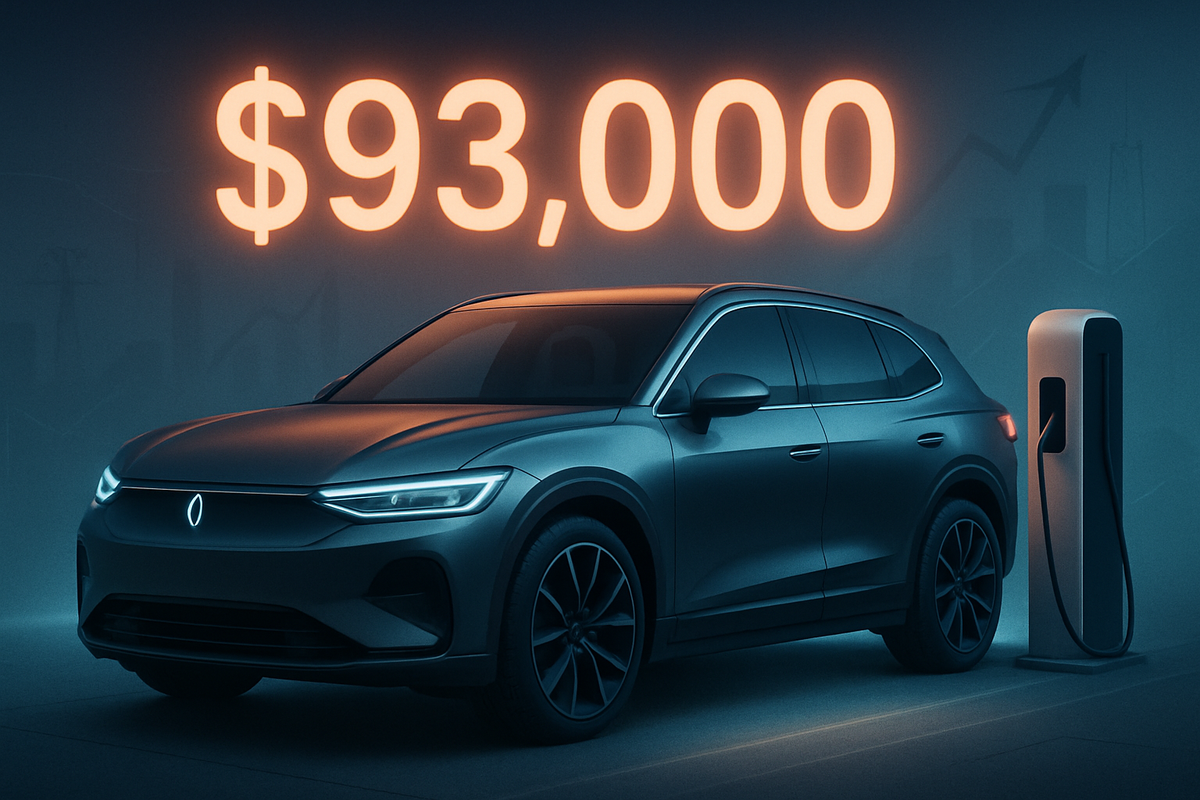U.S. New Car Prices Soar Past $50,000 Mark Amidst EV Rush and Surging Costs

The American automotive market witnessed an unprecedented milestone in September 2025, as the average price of a new vehicle in the U.S. surged to a record-high of $50,080. This marks the first time new car prices have crossed the $50,000 threshold, a significant leap driven primarily by robust demand for electric vehicles (EVs) and escalating manufacturing costs. The immediate implications are a widening affordability gap for consumers and a potential recalibration for automakers navigating a rapidly evolving landscape.
This historic price surge paints a vivid picture of a market in flux, where technological shifts and macroeconomic pressures are reshaping consumer access and industry strategies. While a boon for luxury segments and EV manufacturers, the record prices threaten to sideline a substantial portion of the car-buying public, pushing them towards the used car market or extending vehicle ownership. The long-term effects could lead to a more polarized automotive market and a reevaluation of production and pricing strategies across the board.
Unpacking the $50,080 Milestone: A Confluence of Factors
The record-high average new car price of $50,080 in September 2025 represents a notable 2.1% increase from August 2025 and a substantial 3.6% rise compared to September 2024, according to data compiled by Kelley Blue Book, a brand of Cox Automotive. This significant jump is not merely an incremental shift but rather the culmination of several powerful forces converging on the automotive sector.
A primary catalyst was the intensified demand for Electric Vehicles (EVs). September 2025 saw EVs capture a record 11.6% of the U.S. new vehicle market, with the average transaction price for an EV hitting $58,124 – a 3.5% increase from the previous month. This surge was heavily influenced by a last-minute scramble by consumers to capitalize on federal tax credits, offering up to $7,500 per vehicle, before their expiration on September 30, 2025. This impending deadline fueled a buying frenzy, particularly for higher-priced EV models, artificially inflating average transaction prices across the market.
Beyond the EV phenomenon, rising manufacturing costs played a critical role. Automakers faced "hefty tariffs" on imported auto parts and vehicles, locked in by long-term trade deals, which translated directly into higher production expenses. Cox Automotive estimates these tariffs could add an average of $5,500 to the cost of imported cars and about $1,000 to domestically assembled vehicles due to imported components. Compounding these tariff-related costs were persistent supply chain disruptions, including ongoing semiconductor shortages and elevated logistics expenses, which continued to plague global production throughout 2025. Furthermore, a discernible "rich mix" of luxury vehicles contributed significantly to the higher average. More than 60 models in September boasted average transaction prices exceeding $75,000, accounting for 7.4% of total new vehicle sales, up from 6.0% in September 2024. This trend suggests that the current market is increasingly catering to wealthier households, capable of affording premium vehicles and securing favorable financing, thereby propping up the higher end of the market.
Initial market reactions indicate a growing concern over affordability. While incentive spending by automakers and dealers did increase in September 2025 to 7.4% of the average transaction price (approximately $3,700), the highest level in 2025, it was insufficient to offset the overall price hike. This suggests an attempt to mitigate the sticker shock, but the underlying cost pressures remain. The market is becoming increasingly segmented, with the "affordable" new car segment largely disappearing, pushing many traditional buyers out of contention.
Companies Navigating the High-Price Highway: Winners and Losers
The record-high average new car price creates a distinct landscape of winners and losers across the automotive industry, impacting manufacturers, suppliers, and consumers alike. The dynamics of EV demand and manufacturing costs are reshaping corporate strategies and market valuations.
Potential Winners:
Automakers with a strong portfolio of high-margin luxury vehicles and successful EV offerings are poised to benefit. Companies like Tesla (NASDAQ: TSLA), a dominant force in the EV market, continue to command premium prices, especially with a rush of buyers before tax credit expirations. While their average transaction prices for EVs are already high, the overall market shift validates their premium positioning. Traditional luxury brands such as BMW (XTRA: BMW) and Mercedes-Benz Group AG (XTRA: MBG), which have been steadily increasing their luxury and performance EV offerings, are also likely to see sustained demand from affluent buyers who are less sensitive to price increases. These companies can leverage their brand equity and advanced technology to justify higher price points. Furthermore, companies involved in critical EV components, particularly battery manufacturers like Panasonic Holdings Corporation (TYO: 6752) and LG Energy Solution (KRX: 373220), could see continued strong demand for their products, allowing them to maintain pricing power. Raw material suppliers for EV batteries, such as lithium producers like Albemarle Corporation (NYSE: ALB) and SQM (NYSE: SQM), are also likely to benefit from sustained high demand for electric vehicles, which translates into robust commodity prices.
Potential Losers:
Conversely, automakers primarily focused on entry-level or mid-range conventional vehicles face significant headwinds. Companies like Stellantis N.V. (NYSE: STLA), General Motors Company (NYSE: GM), and Ford Motor Company (NYSE: F), while having luxury and EV divisions, still rely heavily on volume sales in more affordable segments. The disappearance of the "affordable" new car is a direct threat to their traditional market share and profitability in these segments. They will struggle to pass on rising manufacturing costs without alienating their core customer base, potentially leading to reduced sales volumes and increased reliance on incentives, which can erode margins. Dealers, particularly those specializing in non-luxury brands, may also struggle with slower inventory turnover and increased pressure to offer discounts. Consumers, especially those with average incomes, are undoubtedly the biggest losers. Faced with average monthly payments soaring to $754 in Q3 2025 and loan terms extending to seven years or longer, many are priced out of the new car market entirely. This pushes them towards the used car market, increasing demand and potentially prices there, or forces them to prolong the ownership of their current, aging vehicles.
Wider Significance: A Market in Transformation
The record-high new car prices in the U.S. are more than just a fleeting economic statistic; they represent a significant inflection point in the automotive industry, signaling profound shifts in market dynamics, consumer behavior, and regulatory considerations. This event fits squarely into broader trends of electrification, premiumization, and global supply chain vulnerabilities.
Firstly, the surge underscores the accelerating transition to electric vehicles, albeit with a clear premium attached. While the expiring federal tax credits artificially inflated September's EV sales, the underlying trend of increasing EV adoption is undeniable. However, the high average EV transaction price of over $58,000 highlights a critical challenge: making EVs accessible to a broader demographic. This disparity could create a two-tiered automotive market, where sustainable transportation options remain largely within reach of affluent buyers. The ripple effect on competitors and partners is significant. For legacy automakers, the pressure to electrify their fleets intensifies, but so does the challenge of doing so profitably without alienating their traditional customer base. Supply chain partners, particularly those involved in battery technology and critical minerals, will continue to experience robust demand and pricing power, while traditional component suppliers for internal combustion engines might face diminishing prospects.
Regulatory and policy implications are also substantial. The expiration of federal EV tax credits, a major driver of September's sales, will undoubtedly prompt discussions about future incentive structures. Policymakers may need to consider new mechanisms to stimulate EV adoption that are more equitable or targeted, especially if the goal is widespread decarbonization of the transportation sector. Furthermore, the "hefty tariffs" on auto parts and vehicles, identified as a key contributor to rising manufacturing costs, point to the ongoing impact of trade policies on consumer prices. This could reignite debates about the efficacy and long-term consequences of protectionist trade measures on industries reliant on global supply chains. Historically, periods of rapid technological transition in the auto industry, such as the shift from horse-drawn carriages to automobiles or the introduction of mass production, have often been accompanied by initial price volatility and shifts in market accessibility. While the scale is different, the current scenario echoes these historical precedents of market disruption and the eventual need for innovation to drive down costs and expand access.
What Comes Next: Navigating an Evolving Automotive Landscape
The immediate aftermath of the September 2025 record-high new car prices is likely to see a cooling in the electric vehicle market, at least temporarily, and continued pressure on affordability. In the short term, analysts anticipate a sharp decline in EV demand in the fourth quarter of 2025 following the expiration of federal tax credits. Automakers like General Motors Company (NYSE: GM) and Ford Motor Company (NYSE: F), which have invested heavily in EV production, may need to implement aggressive dealer incentives or targeted price reductions to maintain sales momentum, potentially impacting their profit margins. This could lead to a strategic pivot towards more cost-effective EV models or a greater focus on charging infrastructure and software services to add value beyond the vehicle's initial purchase price.
Looking further ahead, the long-term possibilities suggest a fundamental reshaping of the automotive industry. The sustained high prices, particularly those exacerbated by tariffs, are projected to lead to a decrease in overall new car sales in the coming year, with some estimates suggesting a reduction of one million fewer new cars sold due to higher prices alone. This will force manufacturers to adapt, potentially by streamlining model lineups, increasing vertical integration to control supply chain costs, or exploring new ownership models like subscriptions or enhanced leasing options to make vehicles more accessible. Market opportunities may emerge for companies that can innovate in the "affordable EV" space or those that can offer compelling value propositions in the used car market. Challenges include maintaining profitability amidst lower sales volumes and managing the transition from internal combustion engine (ICE) vehicle production to EV production without incurring significant stranded asset costs.
Potential scenarios range from a gradual market correction where technological advancements and increased production scale slowly bring down EV prices, to a more entrenched two-tiered market where premium vehicles dominate new sales and the used market becomes the primary avenue for affordability. Automakers will need to invest heavily in research and development to drive down battery costs and improve manufacturing efficiency. The rise of companies specializing in vehicle longevity and maintenance could also gain traction as consumers hold onto their cars for longer. Regulatory bodies may also intervene with new policies aimed at stimulating competition or providing targeted consumer relief, especially if affordability issues persist and impact economic stability.
Wrap-up: A Market at a Crossroads
The September 2025 record-high average new car price of $50,080 serves as a critical marker in the ongoing transformation of the U.S. automotive market. The confluence of surging electric vehicle demand, amplified by expiring federal tax credits, and persistent inflationary pressures from rising manufacturing costs and tariffs has created an unprecedented pricing environment. The key takeaways are clear: the new car market is becoming increasingly premium, affordability is a growing concern for the average consumer, and the transition to EVs is progressing but faces significant cost-related hurdles.
Moving forward, the market is poised for a period of adjustment. The expected dip in EV sales post-tax credit expiration will test automakers' resolve and innovation in making electric vehicles more attractive without substantial government subsidies. The sustained high prices will inevitably lead to a contraction in overall new car sales, forcing manufacturers to re-evaluate their product strategies and cost structures. This could accelerate the shift towards more efficient production methods and a greater emphasis on value propositions beyond just the sticker price.
The lasting impact of this event will likely be a more segmented and potentially more volatile automotive landscape. For investors, the coming months will be crucial for identifying companies that can successfully navigate these challenges. Watch for automakers demonstrating agility in cost control, innovation in battery technology, and strategic shifts towards more accessible EV models or alternative ownership solutions. Pay close attention to sales figures in the fourth quarter of 2025 and into 2026, particularly for EV segments, as these will indicate the true underlying demand without the artificial boost of incentives. The used car market will also be a bellwether, as increased demand there will reflect the ongoing affordability crisis in the new car sector. The automotive industry is at a crossroads, and the decisions made in response to these record prices will shape its trajectory for years to come.
This content is intended for informational purposes only and is not financial advice
More News
View More



Recent Quotes
View MoreQuotes delayed at least 20 minutes.
By accessing this page, you agree to the Privacy Policy and Terms Of Service.